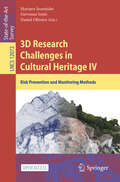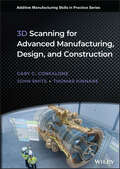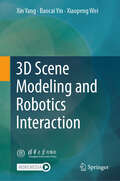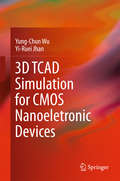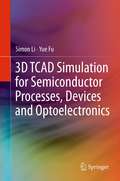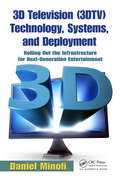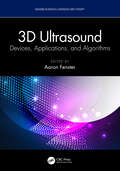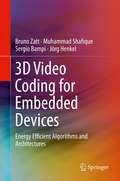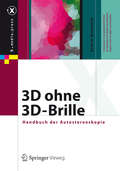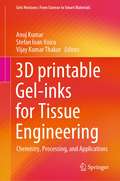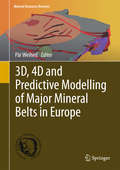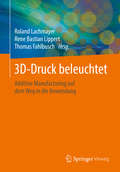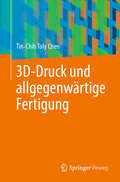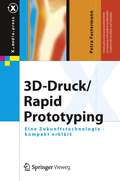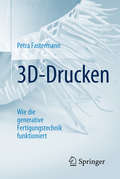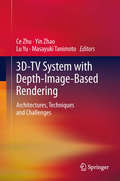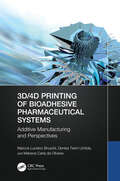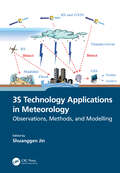- Table View
- List View
3D Research Challenges in Cultural Heritage IV: Risk Prevention and Monitoring Methods (Lecture Notes in Computer Science #13577)
by Marinos Ioannides Daniel Oliveira Giovanni IssiniThis open access book presents a collection of papers focusing on a range of digital technologies and their use in the protection and restoration of cultural heritage. Digital tools - from 3D scanning and photogrammetry to Heritage Building Information Modeling (HBIM), Digital Twins, and Extended Reality (XR) - are transforming the way we understand and care for tangible heritage. These technologies are applied to both record the physical form and material conditions of a site and to permit simulations of deterioration, design interventions, and careful reconstruction. A central theme of this volume is post-disaster restoration and how the scientific and technical aspects of restoration can be made accessible to a broader audience through innovative visualizations, interactive platforms and storytelling. Digital tools should not only serve experts but also allow the public to participate both on-site and remotely via the web. This book advocates a holistic approach to heritage management, combining cutting-edge technology with local knowledge, risk analysis with creative reuse, and positioning the act of restoration as a bridge connecting the past, present and future.
3D Scanning for Advanced Manufacturing, Design, and Construction: Metrology For Advanced Manufacturing (Additive Manufacturing Skills in Practice.)
by Gary C. Confalone John Smits Thomas Kinnare3D Scanning for Advanced Manufacturing, Design, and Construction Learn how 3D scanning technology drives advanced manufacturing and modern construction 3D scanning technology allows non-contact scanning of objects for unprecedented data collection, analysis, and modeling. 3D models created this way are valuable at every stage of the design and build process and they have become a staple in additive manufacturing or 3D printing. As 3D printing transforms global industry at every scale, there has never been a better time for engineers and industrial professionals to be competitive in the area of 3D scanning, a multibillion-dollar market that continues to grow. 3D Scanning Technology for Advanced Manufacturing, Design, and Construction provides a comprehensive introduction to 3D scanning and its applications in both the AEC and manufacturing industries. After establishing the history and basic principles of 3D scanning, it includes discussions of the various scanner types and software interfaces, the use of 3D point clouds for analysis and reverse engineering, and much more. It covers the full range of technology and processes that engineers, architects, and manufacturing professionals use to increase accuracy and quality while reducing project timelines. Readers of 3D Scanning Technology for Advanced Manufacturing, Design, and Construction will also find: Case studies that highlight techniques useful for specific real-world applications Comparisons of various scanning devices and software that aid in choosing the proper technologies for a specific project Resources and references for online learning, organizations, and certifications Perfect for engineers, technicians, students, and industry professionals new to laser scanning, 3D Scanning Technology for Advanced Manufacturing, Design, and Construction will earn its place in libraries of technical, vocational, and continuing education audiences seeking to improve their knowledge of 3D scanning.
3D Scene Modeling and Robotics Interaction
by Xin Yang Baocai Yin Xiaopeng WeiThis book focuses on the intelligent perception and interaction module in intelligent robotic systems, establishes a multidisciplinary cross-fertilization knowledge system, explores the related technology frontiers and research frontiers as comprehensively as possible from the perspective of scene modeling and understanding, and develops a practical exposition of practical application tasks such as robotic navigation, obstacle avoidance, and grasping. The main contents of this book include 3D reconstruction, scene exploration, scene understanding, robot navigation and obstacle avoidance, robot grasping and comprehensive project practice. Combining theory and practice, the book contains both basic algorithms and covers the latest technologies with detailed code or pseudo-code resources. This book can be used as a teaching reference book for information and intelligence related majors in higher education institutions, computer graphics, computer vision and intelligent robotics and other related fields, as well as a reference book for technicians engaged in related fields. This book takes intelligent robots as the carrier, focuses on the technologies of environment perception and understanding and applying them to practical tasks such as robot navigation, obstacle avoidance and grasping. The book consists of six chapters. Chapters 1 to 3 provide a comprehensive introduction to the development and application of scene modeling and understanding technologies, including 3D reconstruction, scene exploration, and scene understanding. Chapters 4 and Chapter 5 provide a comprehensive introduction to the development and application of robot perception technologies, including visual relocalization and robot navigation, obstacle avoidance and grasping. Chapter 6 introduces comprehensive project practice with 3D scene modeling and understanding for robot tasks as an example, which facilitates readers to have a comprehensive understanding and mastery of theory and practice. The translation was done with the help of artificial intelligence. A subsequent human revision was done primarily in terms of content.
3D Stacked Chips: From Emerging Processes to Heterogeneous Systems
by Ibrahim Abe M. Elfadel Gerhard FettweisThis book explains for readers how 3D chip stacks promise to increase the level of on-chip integration, and to design new heterogeneous semiconductor devices that combine chips of different integration technologies (incl. sensors) in a single package of the smallest possible size. The authors focus on heterogeneous 3D integration, addressing some of the most important challenges in this emerging technology, including contactless, optics-based, and carbon-nanotube-based 3D integration, as well as signal-integrity and thermal management issues in copper-based 3D integration. Coverage also includes the 3D heterogeneous integration of power sources, photonic devices, and non-volatile memories based on new materials systems.
3D TCAD Simulation for CMOS Nanoeletronic Devices
by Yung-Chun Wu Yi-Ruei JhanThis book demonstrates how to use the Synopsys Sentaurus TCAD 2014 version for the design and simulation of 3D CMOS (complementary metal-oxide-semiconductor) semiconductor nanoelectronic devices, while also providing selected source codes (Technology Computer-Aided Design, TCAD). Instead of the built-in examples of Sentaurus TCAD 2014, the practical cases presented here, based on years of teaching and research experience, are used to interpret and analyze simulation results of the physical and electrical properties of designed 3D CMOSFET (metal-oxide-semiconductor field-effect transistor) nanoelectronic devices. The book also addresses in detail the fundamental theory of advanced semiconductor device design for the further simulation and analysis of electric and physical properties of semiconductor devices. The design and simulation technologies for nano-semiconductor devices explored here are more practical in nature and representative of the semiconductor industry, and as such can promote the development of pioneering semiconductor devices, semiconductor device physics, and more practically-oriented approaches to teaching and learning semiconductor engineering. The book can be used for graduate and senior undergraduate students alike, while also offering a reference guide for engineers and experts in the semiconductor industry. Readers are expected to have some preliminary knowledge of the field.
3D TCAD Simulation for Semiconductor Processes, Devices and Optoelectronics
by Suihua Li Simon LiTechnology computer-aided design, or TCAD, is critical to today's semiconductor technology and anybody working in this industry needs to know something about TCAD. This book is about how to use computer software to manufacture and test virtually semiconductor devices in 3D. It brings to life the topic of semiconductor device physics, with a hands-on, tutorial approach that de-emphasizes abstract physics and equations and emphasizes real practice and extensive illustrations. Coverage includes a comprehensive library of devices, representing the state of the art technology, such as SuperJunction LDMOS, GaN LED devices, etc.
3D Television (3DTV) Technology, Systems, and Deployment: Rolling Out the Infrastructure for Next-Generation Entertainment
by Daniel MinoliGoing beyond the technological building blocks of 3DTV, 3D Television (3DTV) Technology, Systems, and Deployment: Rolling Out the Infrastructure for Next-Generation Entertainment offers an early view of the deployment and rollout strategies of this emerging technology. It covers cutting-edge advances, theories, and techniques in end-to-end 3DTV sys
3D Ultrasound: Devices, Applications, and Algorithms (Imaging in Medical Diagnosis and Therapy)
by Aaron Fenster3D ultrasound techniques have been increasingly used in diagnosis, minimally invasive image-guided interventions, and intra-operative surgical use. Today, most ultrasound system manufacturers provide 3D imaging capability as part of the systems. This availability has stimulated researchers to develop various machine learning tools to automatically detect and diagnose diseases, such as cancer, monitor the progression and regression of diseases, such as carotid atherosclerosis, guide and track tools being introduced into the body, such as brachytherapy and biopsy needles. This edited book is divided into three sections covering 3D ultrasound devices, 3D ultrasound applications, and machine learning tools using 3D ultrasound imaging and written with physicians, engineers, and advanced graduate students in mind. Features: Provides descriptions of mechanical, tracking, and array approaches for generating 3D ultrasound images Details the applications of 3D ultrasound for diagnostic application and in image-guided intervention and surgery Explores the cutting-edge use of machine learning in detection, diagnosis, monitoring, and guidance for a variety of clinical applications
3D Video Coding for Embedded Devices: Energy Efficient Algorithms and Architectures
by Jörg Henkel Muhammad Shafique Sergio Bampi Bruno ZattThis book shows readers how to develop energy-efficient algorithms and hardware architectures to enable high-definition 3D video coding on resource-constrained embedded devices. Users of the Multiview Video Coding (MVC) standard face the challenge of exploiting its 3D video-specific coding tools for increasing compression efficiency at the cost of increasing computational complexity and, consequently, the energy consumption. This book enables readers to reduce the multiview video coding energy consumption through jointly considering the algorithmic and architectural levels. Coverage includes an introduction to 3D videos and an extensive discussion of the current state-of-the-art of 3D video coding, as well as energy-efficient algorithms for 3D video coding and energy-efficient hardware architecture for 3D video coding.
3D Visual Content Creation, Coding and Delivery (Signals and Communication Technology)
by Pedro Amado Assunção Atanas GotchevThis book covers the different aspects of modern 3D multimedia technologies by addressing several elements of 3D visual communications systems, using diverse content formats, such as stereo video, video-plus-depth and multiview, and coding schemes for delivery over networks. It also presents the latest advances and research results in regards to objective and subjective quality evaluation of 3D visual content, extending the human factors affecting the perception of quality to emotional states. The contributors describe technological developments in 3D visual communications, with particular emphasis on state-of-the-art advances in acquisition of 3D visual scenes and emerging 3D visual representation formats, such as: multi-view plus depth and light field;evolution to freeview and light-field representation;compression methods and robust delivery systems; andcoding and delivery over various channels. Simulation tools, testbeds and datasets that are useful for advanced research and experimental studies in the field of 3D multimedia delivery services and applications are covered. The international group of contributors also explore the research problems and challenges in the field of immersive visual communications, in order to identify research directions with substantial economic and social impact. 3D Visual Content Creation, Coding and Delivery provides valuable information to engineers and computer scientists developing novel products and services with emerging 3D multimedia technologies, by discussing the advantages and current limitations that need to be addressed in order to develop their products further. It will also be of interest to students and researchers in the field of multimedia services and applications, who are particularly interested in advances bringing significant potential impact on future technological developments.
3D and Circuit Integration of MEMS
by Masayoshi EsashiExplore heterogeneous circuit integration and the packaging needed for practical applications of microsystems MEMS and system integration are important building blocks for the “More-Than-Moore” paradigm described in the International Technology Roadmap for Semiconductors. And, in 3D and Circuit Integration of MEMS, distinguished editor Dr. Masayoshi Esashi delivers a comprehensive and systematic exploration of the technologies for microsystem packaging and heterogeneous integration. The book focuses on the silicon MEMS that have been used extensively and the technologies surrounding system integration. You’ll learn about topics as varied as bulk micromachining, surface micromachining, CMOS-MEMS, wafer interconnection, wafer bonding, and sealing. Highly relevant for researchers involved in microsystem technologies, the book is also ideal for anyone working in the microsystems industry. It demonstrates the key technologies that will assist researchers and professionals deal with current and future application bottlenecks. Readers will also benefit from the inclusion of: A thorough introduction to enhanced bulk micromachining on MIS process, including pressure sensor fabrication and the extension of MIS process for various advanced MEMS devices An exploration of epitaxial poly Si surface micromachining, including process condition of epi-poly Si, and MEMS devices using epi-poly Si Practical discussions of Poly SiGe surface micromachining, including SiGe deposition and LP CVD polycrystalline SiGe A concise treatment of heterogeneously integrated aluminum nitride MEMS resonators and filters Perfect for materials scientists, electronics engineers, and electrical and mechanical engineers, 3D and Circuit Integration of MEMS will also earn a place in the libraries of semiconductor physicists seeking a one-stop reference for circuit integration and the practical application of microsystems.
3D ohne 3D-Brille: Handbuch der Autostereoskopie (X.media.press)
by Armin GrasnickSeit dem kommerziellen Erfolg des 3D-Blockbusters ,,Avatar" im Jahr 2009 kommen immer mehr 3D-Filme und 3D-Fernseher auf den Markt. Mittlerweile gibt es Autostereoskopie-Verfahren, bei denen Zuschauer keine 3D-Brille mehr benötigen. In dem Band werden die derzeit verfügbaren Technologien der Autostereoskopie, ihre Funktionsweise, Anwendung und Limitierung allgemeinverständlich beschrieben. Zu jeder Technologie liefert der Band Anleitungen und Beispiele für die Erstellung von 3D-Inhalten. Alle Tools sind auf der begleitenden Internetseite verfügbar.
3D printable Gel-inks for Tissue Engineering: Chemistry, Processing, and Applications (Gels Horizons: From Science to Smart Materials)
by Vijay Kumar Thakur Anuj Kumar Stefan Ioan VoicuThis book provides the necessary fundamentals and background for researchers and research professionals working in the field of 3D bioprinting in tissue engineering. In 3D bioprinting, design and development of the biomaterial-inks/bio-inks is a major challenge in providing 3D microenvironments specific to anatomical and architectural demands of native tissues. The focal point of this book is to provide the basic chemistry of biomaterials, updates on current processing, developments, and challenges, and recent advancements in tissue-specific 3D printing/bioprinting. This book is will serve as a go-to reference on bioprinting and is ideal for students, researchers and professionals, working academia, government, the medical industry, and healthcare.
3D, 4D and Predictive Modelling of Major Mineral Belts in Europe (Mineral Resource Reviews)
by Pär WeihedThis book presents the results of the major EU project Promine. For the first time there is now a European database available on mineral deposits, as well as 3D, 4D and predictive models of major mineral belts in Europe: Fennoscandia (Skellefteå and Vihanti-Pyhäsalmi), the Fore-Sudetic basin (Kupferschiefer deposits in Poland and Germany), the Hellenic belt in northern Greece, and the Iberian Pyrite belt and Ossa Morena zone in Spain and Portugal. The book also describes the modelling techniques applied and how different types of software are used for three- and four-dimensional modelling. Furthermore, fundamental descriptions of how to build the database structure of three-dimensional geological data are provided and both 2D and 3D predictive models are presented for the main mineral belts of Europe.
3D-Druck beleuchtet: Additive Manufacturing auf dem Weg in die Anwendung
by Roland Lachmayer Rene Bastian Lippert Thomas FahlbuschDas vorliegende Buch zeigt einen Überblick über das breite Anwendungsfeld des Additive Manufacturing, mit dem Fokus auf den industriellen Einsatz unterschiedlicher Technologien. Nach der Beschreibung eines allgemeinen Grundverständnisses und der Einschätzung zur Nutzung von Additive Manufacturing Verfahren in der Produktentwicklung werden verschiedene Technologien hinsichtlich von Nachhaltigkeits-, Individualisierungs-, Qualifizierungs- und Gestaltungsaspekten analysiert. Dabei liegt der Fokus stets auf der Betrachtung der gesamten Prozesskette, vom Pre-Prozess über den In- und Post-Prozess bis hin zur Anwendung. Die abschließende Betrachtung von Sicherheitsmerkmalen des Additive Manufacturing resultiert in der Einschätzung zukünftiger Entwicklungen im Bereich des Additive Manufacturing.
3D-Druck und allgegenwärtige Fertigung
by Tin-Chih Toly ChenDieses Buch bietet einen umfassenden Überblick über die Anwendungen von 3D-Drucktechnologien in der allgegenwärtigen Fertigung (Ubiquitous Manufacturing, UM). UM selbst stellt eine Anwendung des Ubiquitären Computings im Fertigungssektor dar, und dieses Buch zeigt, wie es bequemen, bedarfsgerechten Netzwerkzugang zu einem gemeinsamen Pool konfigurierbarer Fertigungsressourcen, einschließlich Software-Tools, Ausrüstung und Fähigkeiten, bietet. Aufgrund seines Umfangs wird das Buch für Forscher in den Bereichen Fertigung, Maschinenbau, Betriebsmanagement, Produktionssteuerung, Ubiquitäres Computing und Sensortechnologien sowie für praktizierende Manager und Ingenieure von großem Interesse sein.
3D-Druck/Rapid Prototyping: Eine Zukunftstechnologie - kompakt erklärt (X.media.press)
by Petra FastermannImmer mehr Kreative nutzen die Möglichkeit, eigene dreidimensionale Objekte in Kunststoff, Metall oder Keramik schnell und preisgünstig herstellen zu lassen. Der 3D-Druck ist eine revolutionäre Technologie, die dieVerwirklichung von Ideen ermöglicht. 3D-Drucker werden immer kleiner und leistungsstärker und damit bürotauglicher. Eine umfassende Beschreibung dieser Zukunftstechnologie bietet dieses praxisnahe und anwenderorientierte Buch. Dabei hilft es mit Tipps und Hinweisen bei der Auswahl des optimalen CAD-Programms und 3D-Druckers.
3D-Drucken: Wie die generative Fertigungstechnik funktioniert (Technik im Fokus)
by Petra FastermannDas 3D-Drucken entwickelt sich rasant. L#65533;ngst ist der 3D-Druck f#65533;r Interessierte eine Fertigungs-Technologie, die sie selbst nutzen m#65533;chten. Doch welche M#65533;glichkeiten bietet 3D-Druck? Welche neuen Entwicklungen gibt es? Wie hat sich 3D-Druck etabliert? Was ist in den letzten Jahren selbstverst#65533;ndlich geworden? Was ist verbessert worden? Mit der zweiten, #65533;berarbeiteten und aktualisierten Auflage beantwortet die Autorin diese Fragen. Die 3D-Druck-Technologie wird - auch f#65533;r Nicht-Techniker - verst#65533;ndlich erkl#65533;rt. Hinweise auf kostenlose 3D-CAD-Software-Programme und weiterf#65533;hrende Literatur laden dazu ein, das Gelesene zu vertiefen und selbst anzuwenden.
3D-Drucken: Wie die generative Fertigungstechnik funktioniert (Technik im Fokus)
by Petra FastermannWie funktioniert 3D-Druck? Wofür eignet sich welche 3D-Druck-Technologie? Was bedeutet 3D-Druck für den Einzelnen? Welche gesellschaftlichen und wirtschaftlichen Veränderungen wird es durch diese Zukunftstechnologie geben? Die Autorin gibt Antworten auf diese Fragen. Sie führt präzise und einfach in die immer populärer werdende Technologie des 3D-Drucks ein. Die Leser werden so in den Stand versetzt, 3D-Druck selbst anzuwenden. Sie lernen, kostenlose Software auszuprobieren oder vielleicht sogar in einer der immer zahlreicher werdenden offenen Werkstätten (FabLabs) einen 3D-Drucker selbst zu nutzen.
3D-Spannungsanalyse von linear elastisch homogenen Körpern: Analytische Lösungsmethoden für kontinuumsmechanische Probleme (essentials)
by Manfred Hahn Rafael D. JarzabekManfred Hahn und Rafael D. Jarzabek stellen zwei neue analytische 3D-Lösungen in der Kontinuumsmechanik vor. Diese analytischen Lösungen können zur Verifikation von numerischen Lösungsmethoden herangezogen werden. Beginnend wird in diesem essential die geschichtliche Entwicklung der analytischen Lösungsmethoden in der Kontinuumsmechanik für den 2D- und 3D-Raum und die daraus entstandenen Probleme aufgeführt. Da die Weiterentwicklung der analytischen Methoden aufgrund der mathematischen Schwierigkeiten vor einigen Jahrzehnten stagnierte und die Anwender numerische Methoden wegen der Entwicklung des Computers bevorzugten, wurden fortwährend nur noch numerische Lösungen für spezielle Probleme berechnet. Heute ist die Mathematik aber weiter, sodass nun doch neue analytische Lösungen gefunden werden können. Dazu stellen die Autoren die ursprünglichen Lösungsansätze vor und vergleichen sie mit dem neuen Lösungsverfahren von Pagano.
3D-TV System with Depth-Image-Based Rendering: Architectures, Techniques and Challenges
by Masayuki Tanimoto Ce Zhu Lu Yu Yin ZhaoRiding on the success of 3D cinema blockbusters and advances in stereoscopic display technology, 3D video applications have gathered momentum in recent years. 3D-TV System with Depth-Image-Based Rendering: Architectures, Techniques and Challenges surveys depth-image-based 3D-TV systems, which are expected to be put into applications in the near future. Depth-image-based rendering (DIBR) significantly enhances the 3D visual experience compared to stereoscopic systems currently in use. DIBR techniques make it possible to generate additional viewpoints using 3D warping techniques to adjust the perceived depth of stereoscopic videos and provide for auto-stereoscopic displays that do not require glasses for viewing the 3D image. The material includes a technical review and literature survey of components and complete systems, solutions for technical issues, and implementation of prototypes. The book is organized into four sections: System Overview, Content Generation, Data Compression and Transmission, and 3D Visualization and Quality Assessment. This book will benefit researchers, developers, engineers, and innovators, as well as advanced undergraduate and graduate students working in relevant areas.
3D/4D Printing of Bioadhesive Pharmaceutical Systems: Additive Manufacturing and Perspectives
by Marcos Luciano Bruschi Denise Tiemi Uchida Mariana Carla de OliveiraThis book features a brief history of additive manufacturing and 3D/4D printing techniques, as well as the advantages, applications, and overall challenges facing the technology. It then focuses on the applications of bioadhesive systems for drug delivery.3D/4D Printing of Bioadhesive Pharmaceutical Systems: Additive Manufacturing and Perspectives, explores recent discoveries of 3D printing in the development of pharmaceutical systems and drug delivery. Specifically, it discusses the main polymers/materials used in the development of bio-adhesive pharmaceutical systems and explains the importance of bio-adhesiveness of drug release through 3D printing. The authors also introduce the main strategies necessary to achieve a proper drug delivery system through 3D printing, and examine the adhesiveness of these systems on the skin as the mucosa decreases with the elimination of the drug by the body. Finally, the book brings all the necessary specifications to obtain a bioadhesive system with suitable bio-ink to obtain the best 3D/4D printing.This book is written with the objective of helping students start their studies in pharmaceutical engineering, bioengineering and additive manufacturing. Moreover, engineering professionals can use the book to improve the performance of 3D/4D printers for this type of system.
3DTV
by Erhan Ekmekcioðlu Stewart T. Worrall Anil FernandoA novel and timely primer to the 3DTV system chain from capture to displayThis book examines all aspects of the 3DTV chain, from capture to display. It helps the reader learn about the key issues for 3DTV technology. It also provides with a systems level appreciation of 3DTV systems, and an understanding of the fundamental principles behind each part of the chain. At the end of each chapter, the author provides resources where readers can learn more about the technology covered (e.g. more focused text books, key journal papers, and key standards contributions).Provides a fundamental and systematic introduction and description of 3DTV key techniques, which build up the whole 3DTV system from capture to consumer viewing at the home.Addresses the quick moving field of 3D displays which is attracting increasing interest from industry and academia.Concepts in the book will be illustrated using diagrams and example images of processed 3D content. The 3D content will be presented as 2D images in the book.Authors to host website providing pointers to more information on the web, freely available tools which would enable readers to experiment with coding video, simulate its transmission over networks, play it back in 3D, and measure the quality and links to important news and developments in the field.
3G, 4G and Beyond: Bringing Networks, Devices and the Web Together
by Martin SauterExtensively updated evaluation of current and future network technologies, applications and devices This book follows on from its successful predecessor with an introduction to next generation network technologies, mobile devices, voice and multimedia services and the mobile web 2.0. Giving a sound technical introduction to 3GPP wireless systems, this book explains the decisions taken during standardization of the most popular wireless network standards today, LTE, LTE-Advanced and HSPA+. It discusses how these elements strongly influence each other and how network capabilities, available bandwidth, mobile device capabilities and new application concepts will shape the way we communicate in the future. This Second Edition presents a comprehensive and broad-reaching examination of a fast-moving technology which will be a welcome update for researchers and professionals alike. Key features: Fully updated and expanded to include new sections including VoLTE, the evolution to 4G, mobile Internet access, LTE-Advanced, Wi-Fi security and backhaul for wireless networks Describes the successful commercialization of Web 2.0 services such as Facebook, and the emergence of app stores, tablets and smartphones Examines the evolution of mobile devices and operating systems, including ARM and x86 architecture and their application to voice-optimized and multimedia devices
3S Technology Applications in Meteorology: Observations, Methods, and Modelling
by Shuanggen JinSpatial information technology and its integration, such as remote sensing, geographic information systems (GIS), and global navigation satellite systems (GNSS), known as 3S technology, have been extensively utilized in managing and monitoring natural disasters. This book illustrates the 3S integrated applications in the field of meteorology and promotes the role of 3S in developing precise and intelligent meteorology. It presents the principles of 3S technology and the methods for monitoring different meteorological disasters and hazards as well as their application progress. The case studies from the United States, Japan, China, and Europe were conducted to help all countries understand the 3S technology functions in handling and monitoring severe meteorological hazards. FEATURES Presents integral observations from GNSS, GIS, and remote sensing in estimating and understanding meteorological changes Explains how to monitor and retrieve atmospheric parameter changes using GNSS and remote sensing Shows three-dimensional modelling and evaluations of meteorological variation processing based on GIS Helps meteorologists develop and use space-air-ground integrated observations for meteorological applications Illustrates the practices in monitoring meteorological hazards using space information techniques and case studies This book is intended for academics, researchers, and postgraduate students who specialize in geomatics, atmospheric science, and meteorology, as well as scientists who work in remote sensing and meteorology, and professionals who deal with meteorological hazards.
